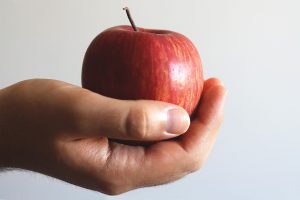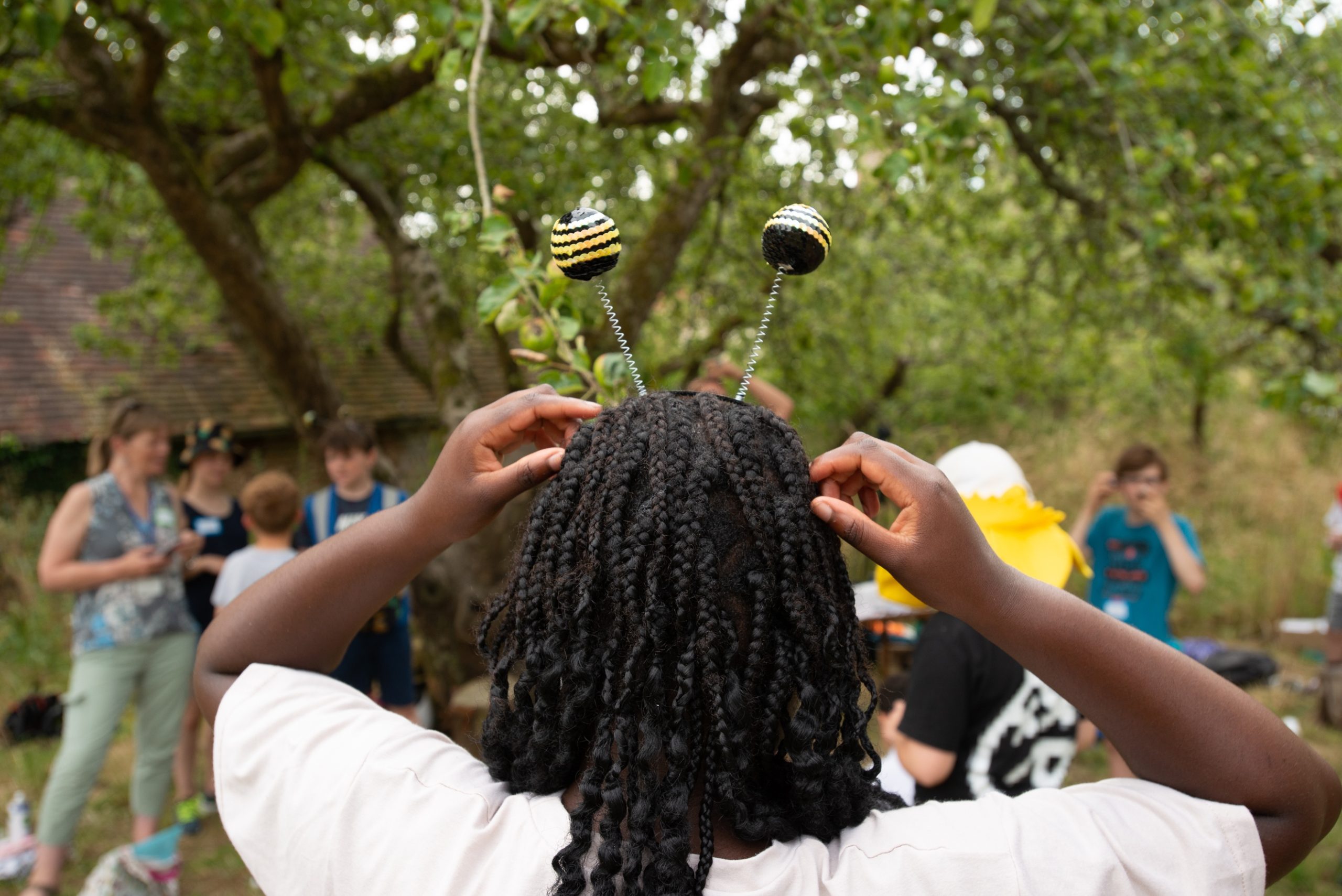Topic 5: Apples
 Brief Encounter
Brief Encounter
Apples and us: how do you respond to apples?
1. Listen to the meditation on an apple (below) being read aloud and take a moment, remaining silent, to take in and experience what you have heard.
2. Use your senses to describe how apples feel, look, sound, smell, taste to you.
How do they make you feel?
What do they make you think of?
3. Create a Haiku to convey your experience of apples.
You might find inspiration by looking up the hundreds of different apple varieties and their unusual names, or by looking at other writing about apples – here are two examples:
Turn this way!
I too feel lonely
Late in autumn
Matsuo Basho
an apple a day
will keep the doctor away
well that’s what they say
Angela Kirby
For the love of apples: a meditation
 Hold an apple in your hands, shut your eyes, breathe in its scent, imagine how it will feel to bite into the crisp flesh, taste that sweet freshness, allow its juices to trickle down your thirsty throat.
Hold an apple in your hands, shut your eyes, breathe in its scent, imagine how it will feel to bite into the crisp flesh, taste that sweet freshness, allow its juices to trickle down your thirsty throat.
Now open your eyes, caress your apple’s smooth cheeks, reflect on its journey, how all its forbears come from ancient trees that grew long, long ago in Kazakhstan, Uzbekistan, Afghanistan, beautiful names for distant places. There they were treasured and tended lovingly for thousands of years. Now we too attend to our orchards, giving thanks to those long ago ancestors who unknowingly bequeathed this precious fruit to us. We remember the bees, wasps and moths that pollinate the trees, and the unseen soil community of bacteria, protozoa, yeasts, fungi, worms, beetles and mites.
Imagine all the children who have raided those orchards, shared their guilty pleasures, and remember too those elders who brewed rough powerful scrumpy and smooth sparkling ciders to ease their working days.
How far you have come, my sweet red apple, how widely you have spread, how many young you have spawned from those small black seeds that nestle in your heart. You are not proud, you allow bees deep into your blossom, let birds and beasts eat your flesh, spatter your magical seeds generously across the world, you permit children to fight or play ‘catch’ with you, leaving your seeds and broken flesh to settle in fields, hedgerows and ditches, you reach out to the poor, to the hungry, to the traveller, nurturing refugees, soldiers and sailors far from family and home. With you in my pocket, oh lovely apple, I shall go happily on my way.
Angela Kirby
Fostering an affinity for everyday foods that we can take for granted
Opportunities for Embracing Uncertainty
This activity requires students to slow down to pay attention to the wonders of those things we take for granted. You may want to do the activities outside to connect to senses and to transport the imagination to where an apple might be grown.
Growing foods calls on an ability to care and attend to the needs of the plant or tree, while recognising that we, as humans, are not fully in control of what might happen. With apples, this includes its journey through time and space, how much fruit might be produced, possibly as a result of threats from pests or weather conditions, the prevalence of pollinating insects, and how its taste can vary yearly.
Opportunities for All Students
This invitation is appropriate for students of all ages. Some will enjoy the pleasures of feeling, tasting and thinking about apples. For others, this activity also encourages them to relook at something that they might think they know well, to consider what more might be revealed. They might extend this practice of paying attention to thinking about other aspects of their studies or lives, where a slowing down allows a renewed perspective. A longer beautiful apple meditation can be found at the following site (we recommended shortening it to include only paragraphs 3, 4, 9, 10, 11, and 15 from line 3): https://www.ecoliteracy.org/article/meditations-apple
Opportunities for Creativity
Haikus provide a tight structure, within which there are infinite possibilities for imagination and creativity (which is itself a paradox). Information on different apple varieties and names can be found here: www.nationalfruitcollection.org.uk. When first attending to their apple, there may be possibilities to cut it open offering a link to fractions. Cutting horizontally reveals the wonder of the star shape of the core: this geometry might prompt connections to mathematics and to other five-pointed stars in nature (e.g. Morning Glory flowers, starfish, raspberry sepals).
An alternative starting provocation is to ask students to write the first thing that comes to mind when the word ‘apple’ is spoken: explore how many identified a fruit; a technology company; a Garden of Eden association within Judaism, Islam and Christianity; or something else. This can be used to discuss apples as metaphors, which might lead to a discussion on the power of branding and the use of nature to sell products.
Opportunities for Linking to Climate Justice
The haiku, which is itself a cultural variation of poetry, lends itself to engage with the diversity of language used to name and describe apples in multiple languages. This challenge provides an opportunity for students to act as apple researchers. For example, they can investigate how apples are migrants, rather than indigenous to the UK, originating from the east. These sites might be helpful:
https://www.britishapplesandpears.co.uk/
https://www.bbc.com/future/article/20160523-kazakhstans-treasure-trove-of-wildly-flavoured-apples
https://www.bbc.com/travel/article/20181120-the-birthplace-of-the-modern-apple
More advanced students could engage with Henry Thoreau’s (1862) Wild Apples: The History of the Apple Tree, exploring the question of why wild apples are significant, which also includes references to different practices across times and cultures, including ‘apple-howling’: https://www.theatlantic.com/magazine/archive/1862/11/wild-apples/411517/
 Deliberative Encounter
Deliberative Encounter
Can you consider environmental scenarios from different perspectives?
1. Watch this film about a couple of orchards:
https://brightonpermaculture.org.uk/orchards-and-fruit/our-work-with-orchards-and-fruit/#
Whilst watching the film, pay attention to the following:
- Notice how different humans experience the orchard.
- Have you ever been in an orchard? What did you do there? How did you feel?
- If you were in an orchard now, what would you want to be doing?
- Have you both given similar or different answers?
2. Share with a partner what you noticed, thought and felt, and listen to what they tell you. Did your partner tell you something that you’d not thought of before?
3. Now reflect on these questions:
- What key messages did you take from the film? What did you think or feel about what was communicated?
- Think about and discuss the value and challenges of diversity in your own community?
Uncertainty as a driver of new knowledge
Opportunities for Embracing Uncertainty
This film reveals the importance of a diversity of species, including varieties of apples and different plants and animals. It also shows the interdependence between the human and nonhuman worlds, where we require foods to survive, but must cultivate conditions for foods to grow. Humans also enjoy and benefit from the ambience and richness of the orchard setting, which become places for a slowing down, where unexpected, emotional and existential encounters might happen.
Opportunities for All Students
This activity is suitable for all students. Some may draw on their experiences of trees, being outside and eating fruits, to help them reflect on how orchards might make people feel and what they have to offer human and nonhuman communities. Others can think deeply about the range of diversity issues in the film (see below). The film emphasises resilience and diversity as opposed to monocultures, and students might consider the challenges to growing apples as result of climate change and biodiversity loss (e.g. disease; pollinator population collapse; late frosts; storms; drought).
Opportunities for Creativity
The film can be used to prompt several opportunities for developing creative thinking: What part do orchards play in our local community? What are the challenges of running a community orchard? Can we create an apple press at school? What knowledge would we need? Who would we consult? How can we make this happen?
Opportunities for Linking to Climate Justice
The orchards in the film are used by a diversity of community groups, including those of different ages, social class and experience. Some students can explore diversity through making connections to biology and ecology; exploring human dimensions of social and cultural diversity; and considering how diversity of habitats as well as different knowledges and cultures might help to address climate change.
Uncertainty Pollinator Session
Below is a companion activity exploring the uncertainty of bee survival including the impact of habitat loss and bees having to travel further to collect nectar.
- Pollinators, such as bees, moths and hoverflies, are declining. Scientists suggest some reasons for bee decline, but there is also a lot of uncertainty about the scale of decline in some places in some circumstances. What can you find out, what don’t you know, what are you left wondering?
2. Split your group into half. Half of you dress up as flowers (e.g. flower hat/crown) and half dress up as bees (e.g. antennae). The flowers should spread out a bit so that the bees have to run some way between them.
The role of the flowers is to attract the bees, who will visit them and collect pollen (fuzzy balls) and carry it to another flower, pollinating it. The role of the bees is to visit a flower, collect and take away some pollen from their hand (e.g. sticky arm band) and deliver it to another flower. To make this more complicated you can have flowers of different types (e.g. different colours), and a flower can only be pollinated by pollen from a flower of the same type (e.g. the same colour).
Once pollinated (i.e. once receiving pollen from a bee) the flower should crouch down and develop into a seed and then a fruit. Think about how you will represent this (e.g. by acting, using a picture, an object or piece of clothing).
To attract the bees the flowers have nice colourful petals and strong scents, but in this game they can also use their voices to call to the bees and say nice things to them. What will the flowers say to attract the bees?
The aim is for the flowers to get pollinated as quickly as possible. To make it more urgent you can give a time limit to the game but try to make sure every flower does get pollinated.
3. When you have run the game once and the bees have had fun running about, you repeat it but with only about half the number of bees.
As the antennae are ceremoniously removed from half the bees’ heads, discuss reason for their populations decline (e.g. you ran out of food, you were poisoned by pesticides, you got a disease). This time many of the flowers will not be pollinated within the allotted time as there are not enough bees to travel between the flowers. Alternatively, you could keep the same number of bees, and the same time limit, but spread the flowers out further.
4. After this activity, consider these questions:
- What did this make you think?
- What did you feel?
- What are you left wondering?

 Visual Encounter
Visual Encounter
Looking at diversity

The image to the left represents the number of apple varieties sold in UK supermarkets. The image to the right represents the number of apple varieties grown in UK orchards.
- What do you notice?
- What do you think?
- What do you feel? Why?
- What questions do you have? And where could you find some answers?
- What might you do?
Working with scale
Opportunities for Embracing Uncertainty
Students will respond to this provocation in their unique ways. They might be drawn to the aesthetic of the image as much as the power of its message, which for each student will resonate differently. The activity might generate a range of questions: the answers for many of these will be unknown or hard to respond to definitively (e.g. why do supermarkets select only these particular apples to sell; does the selection change or remain the same, and why might this be?).
Opportunities for All Students
For some students, this image can be used alongside maths activities on quantity and representing quantity: they might recreate the ratio using different objects. Some students might want to contact a supermarket, or the British Apples & Pears organisation which aims for at least 60% of apples sold in the UK to be British by 2030 (https://www.britishapplesandpears.co.uk/the-organisation/), to ask questions about the decisions these organisations feel they have to make about what they grown and sell, as well as the possibilities to include more diverse varieties.
Opportunities for Creativity
The images might be used to stimulate students’ own ideas of representing diversity (or lack of it) either through a grid like images or something else. Students could look up some of the varieties of apples (from the sites mentioned earlier) and add representations of these into their artworks. They might also play on the language of existing names or invent their own. An additional task, for students in primary school, would be to place their own-made apples on a large drawing of a tree, helping to convey ideas of quantity and diversity.
Opportunities for Linking to Climate Justice
The variety of apples connects well to discussions on the value of diversity (and its benefits beyond monocultures). The richness of the history of the varieties and their names can prompt discussion about where these names might have come from, and whether they are historically ‘British’ and/or connect in some way to other places.
 Beyond the Classroom Encounter
Beyond the Classroom Encounter
Thinking about our relationship with the local environment
Take a walk around your local area. During the walk:
1. Notice the different things the ground is used for and where the areas of diversity are.
This could be a diversity of plants, animals, humans, or things such as buildings, equipment, technology, transport.
2. Identify an area where it might be possible to plant an orchard of 8 or more trees.
Take a photograph. For example, this might be a bit of land that no one is using, an area of park where new trees could be planted, or land between buildings or other structures.
3. Discuss your idea of growing an orchard in this place with your family, friends and neighbours, to see what they think.
4. Share your photograph in class and tell others:
- Where is it?
- Why do you think it might be a good place to grow food that could be eaten?
- Who might have an opinion or feelings about changing how this place is used (and why)?
- Who would eat the food? Who might decide?
Invite questions and comments from your peers to hear what they think about your suggestion.
Working with multiple perspectives to adapt local environments
Opportunities for Embracing Uncertainty
Considering where and how to change a piece of local land requires students to think about where might be appropriate to grow food, as well as to consider different perspectives. Both considerations are full of uncertainty. Students are encouraged to engage with a wide range of opinions or feelings in their local community. If this activity is done in class, students could be encouraged to speak with those with whom they may not regularly come into contact who have knowledge of and an interest in public land use (such as local planning officers). This consideration of other perspectives encourages them to engage with complexity and to look beyond simple assertions about what must change.
Opportunities for All Students
All students can engage in this activity of noticing how land is used (and disused/neglected) and talking with those they know. With parental support, some might reach out to ask others in their community that they know less well or not at all (such as neighbours). Some can be encouraged to consider the detail of who might be needed to look after the orchard, to care for the trees and land, to harvest the fruit, as well as to deliberate the rights to the land and access to grown food. This could be a good introduction to local government procedures and the challenges of democratic processes that must account for competing perspectives when making decisions. If doing this with your own class, you might ask them: if you wanted to plant the orchard, how would you ensure that everyone feels heard and their views are taken seriously?
Opportunities for Creativity
This activity requires students to imagine other possibilities for land use. To foster this imagination, they might be encouraged to draw, map out, photograph from different angles, and annotate visuals. They may need to think through different ways to present and share their ideas and what they have discovered about what others think: this requires students to consider why people have different views. Students might also be encouraged to create the imagined space, using drawings, written stories or building small dens in an outdoor space, for example, in which they make up the names, plants and species for whom it becomes a home, as well as the different people who congregate there.
Opportunities for Linking to Climate Justice
This activity engages with a diversity of views, enabling students to take seriously those who think differently. With time, they come to an informed position themselves, one that takes account of others’ knowledge, experiences and perspectives. They might draw on older generations’ experiences of growing things, as well as family and friends from other cultural backgrounds with knowledge of different plants and growing practices. Students could discuss how property rights in their context might be different in other country contexts.

